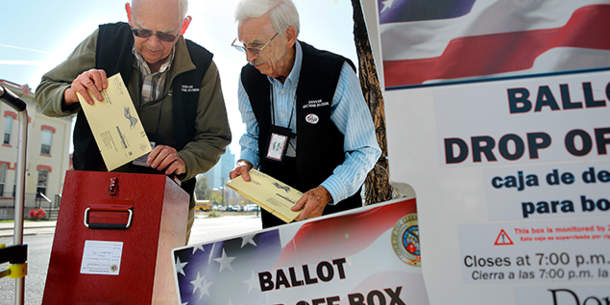Read our 2018 Democracy report here.
Millions of Americans are given a single day to vote. That day is a Tuesday — a work day, when voting will inevitably be squeezed in among errands and jobs. Unsurprisingly, the result is chaos at the polls when work typically gets out, infuriatingly long lines, and mistakes by overwhelmed election officials.
Over the past few decades, 32 states have responded by passing laws that let citizens vote in person before Election Day.[1] Americans can now vote on their own time — weekends included — and can usually avoid long lines.
But starting in 2011, several states started restricting early voting. In North Carolina, the legislature slashed seven early voting days, removing times that were especially popular among African Americans. Among these: the Sunday before the election, used by churchgoers for a “Souls to the Polls” drive. In the prior election, more than one-quarter of all African-American voters in the state had voted on those days.[2] In 2012, Florida dramatically reduced early voting. After exceptionally long lines — which disproportionately impacted African Americans and Hispanics — prevented 200,000 from voting and caused a national outcry, the legislature backtracked and reinstated most of the days it had eliminated.[3] Overall, eight states have new laws cutting back on early voting days and hours.[4]
This is a step in the wrong direction. In 2014, turnout plunged to 36.4 percent, and the number one reason that Americans didn’t vote was that they were “too busy.”[5] Americans now work longer hours than ever before, and longer than anywhere else in the industrialized world.[6] Given such a busy population, a single day to vote helps to ensure low turnout.
Proposal
We need more opportunities to vote, not less. Expanding early voting solves the problem. Nationwide, every state should offer early in-person voting a minimum of two full weeks before Election Day, including weekend and evening hours.[7]
Some states already meet this standard, opening the polls a few weeks before Election Day, while others allow voters to submit absentee ballots in person without an excuse, among other options.[8]
Early voting eases congestion on Election Day, leading to shorter lines, improved poll worker performance, and improved voter satisfaction. It also allows for earlier correction of registration errors and voting system glitches.[9]
Congress can play its part by passing legislation to set minimum early voting requirements for the states. This mandate is one of numerous reforms offered in the Voter Empowerment Act (H.R. 12).
Why This Can Be Achieved
The general public and election officials both support early voting because they understand it increases convenience for voters and reduces the burden on administrators.
One recent poll found 75 percent of likely voters support early voting, with 60 percent expressing “strong” support.[10] A 2013 poll of North Carolina voters found 85 percent of respondents back early voting, including more than 75 percent of Republicans.[11] Americans also oppose efforts to restrict early voting — an October 2014 poll found only 11 percent of voters supported reducing early voting before Election Day.[12]
Early voting was one of the principal recommendations of the bipartisan Presidential Commission on Election Administration. “[E]arly voting offers Americans opportunities to participate in the electoral process that simply cannot be afforded by [a] contained twelve-hour period,” it wrote. “Election officials from both parties testified to the importance of early voting in alleviating the congestion and other potential problems of a single election day.”[13]
Efforts to expand early voting can also draw on the long-term success the policy as had in spreading throughout the country: The majority of states now offer early in-person voting, and bills to establish it have been introduced in almost all the remaining states.[14]
Resources
- Early Voting: What Works: Report, based on interviews with election officials and an analysis of state laws, that details early voting benefits.
- How to Fix the Voting System: Highlights best practices in modernizing voter registration, expanding early voting, improving management of polling place resources, and improving the usability of ballots and voting machines.
Next: Restore Voting Rights to Citizens with Past Criminal Convictions
[1] Diana Kasdan, Brennan Ctr. for Justice, Early Voting: What Works 2 (2013), available at https://www.brennancenter.org/sites/default/files/publications/VotingReport_Web.pdf.
[2] Wendy R. Weiser, How Much of a Difference Did New Voting Restrictions Make in Yesterday’s Close Races?, Brennan Ctr. for Justice, Nov. 5, 2014, http://www.brennancenter.org/blog/how-much-difference-did-new-voting-restrictions-make-yesterdays-close-races.
[3] Tomas Lopez, Florida’s Voting Debacles Continue With Restrictive Absentee Ballot Rules, Brennan Ctr. for Justice, Dec. 10, 2013, http://www.brennancenter.org/blog/floridas-voting-debacles-continue-restrictive-absentee-ballot-rules.
[4] Brennan Ctr. for Justice, States With New Voting Restrictions Since the 2010 Election, http://www.brennancenter.org/new-voting-restrictions-2010-election.
[5] Scott Clement, Why Don’t Americans Vote? We’re “Too Busy,” Wash. Post, July 17, 2015, http://www.washingtonpost.com/news/the-fix/wp/2015/07/17/why-dont-americans-vote-were-too-busy/.
[6] Dean Schabner, Americans: Overworked, Overstressed, ABC News, May 2014, http://abcnews.go.com/US/story?id=93604&page=1&singlePage=true.
[7] Diana Kasdan, Brennan Ctr. for Justice, Early Voting: What Works 1 (2013), available at https://www.brennancenter.org/sites/default/files/publications/VotingReport_Web.pdf.
[8] The Presidential Comm’n on Election Admin., The American Voting Experience: Report and Recommendations of the Presidential Commission on Election Administration 55 (2014), available at https://www.supportthevoter.gov/files/2014/01/Amer-Voting-Exper-final-draft-01–09–14–508.pdf.
[9] Diana Kasdan, Brennan Ctr. for Justice, Early Voting: What Works 1 (2013), available at https://www.brennancenter.org/sites/default/files/publications/VotingReport_Web.pdf.
[10] Lake Research Partners, Voting Rights and Reform: Major findings from 2012/2013 research: Early voting and Same-Day Registration.
[11] Poll: Strong Majority of N.C. Voters Support Early Voting, North Carolina Ctr. for Voter Ed., June 2, 2013, http://ncvotered.com/research/2013/6_3_13_early_voting_poll.php.
[12] Ariel Edwards-Levy, New Early Voting Restrictions Have Little Support Among Americans, Huffington Post, Oct. 17, 2014, http://www.huffingtonpost.com/2014/10/16/early-voting-poll_n_5992638.html.
[13] The Presidential Comm’n on Election Admin., The American Voting Experience: Report and Recommendations of the Presidential Commission on Election Administration 54–55 (2014), available at https://www.supportthevoter.gov/files/2014/01/Amer-Voting-Exper-final-draft-01–09–14–508.pdf.
[14] See Absentee and Early Voting, NAT’L CONF. OF STATE LEGS, http://www.ncsl.org/research/elections-and-campaigns/absentee-and-early-voting.aspx (last visited Feb. 4, 2016); Voting Laws Roundup 2014, BRENNAN CTR. FOR JUSTICE (Dec. 18, 2014), http://www.brennancenter.org/analysis/voting-laws-roundup-2014#_ftnref11.
